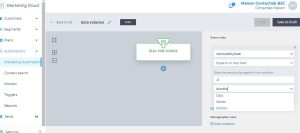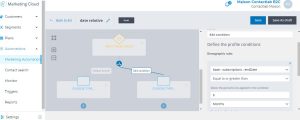From May 5th, 2020, a new Flow version is available.
The release is planned between noon and 12:30 pm CEST.
What does this release enable you to do?
It becomes possible to express conditions based on relative dates on the attributes of the profile date and events date within the source or in the checks of your journey
Let’s try to see it better with an example.
Two traveler friends have both entered your automation after subscribing to the new newsletter that you have designed to support your contacts in the post lockdown. An appointment that newsletter after newsletter helps them to understand the good practices to implement and the warnings to follow, in order to leave safely and compliant.
 One of them, however, is an old contact, a customer for years who already follows you on many communication channels. You know that he is a skilled climber, he often stays in mountain villages and travels a lot on his own during the weekend. The other one is a new entry and you know that he is a friend of the first one because the subscription to the newsletter was suggested by him through “share” CTA. In filling out the subscription form he was accurate and left you a lot of information: he loves long distance trips, his favorite destinations are the tropical seas and above all he always travels with his family composed of two adults and two children under 6 years old.
One of them, however, is an old contact, a customer for years who already follows you on many communication channels. You know that he is a skilled climber, he often stays in mountain villages and travels a lot on his own during the weekend. The other one is a new entry and you know that he is a friend of the first one because the subscription to the newsletter was suggested by him through “share” CTA. In filling out the subscription form he was accurate and left you a lot of information: he loves long distance trips, his favorite destinations are the tropical seas and above all he always travels with his family composed of two adults and two children under 6 years old.
You are therefore faced with two people who have subscribed to the same service – the post-lockdown newsletter – and therefore left for them the same journey but:
- They’ve been among your contacts for a different time, from different dates.
- They have different interests.
You can therefore prepare the same automation for them but once they have started, you can plan different actions and/or communications, in different times and ways, all depending on the fact that they have entered your db at different dates.
The same logic could be applied to many other scenarios basing the condition for example on the moment of the first purchase or the date of a future departure or other data that could be relevant for your goal.
How it works
Let’s take our example. Suppose we choose, as we said, the date of the subscription in the db for creating the condition and deciding in which branch of the automation each contact enters.
In the profile the DATA_INSCRIPTION attribute collects the information you need and then in the source or in the flow checks you can enter a condition of this type:
“DATA_SUBSCRIPTION” “greater than” “(today) -6 months”.
which means that, in order to be verified, the condition requires that at the time of its evaluation – i.e. today – the customer has been subscribed for less than 6 months.
 |
 |
As the first friend, the climber, has been in your db since February 2015, he does not respect the above condition. He will continue in your automation in the B branch, will receive important information for the post lockdown dedicated to all but also specific content reserved only for the most obsolete contacts such as a survey to qualify and update all his data perhaps in exchange for coupons on his next trip.
The sea lover, on the other hand, only entered your db in March 2020. He responds perfectly to the condition set. His journey will continue in branch A, he will receive the same information as his friend on the post lockdown but among the proposed content he will find a box dedicated to the stories of customers who have already experienced the thrill of traveling with you in exotic destinations and a welcome coupon to be used within 6 months after the end of the lockdown.
What does this mean?
Further increase the quality of your flows by refining the conditions that allow you to better manage time and content. You can also customize the travel of each contact according to when an action has been taken or an event has occurred.
 |
 |
 |
 |

